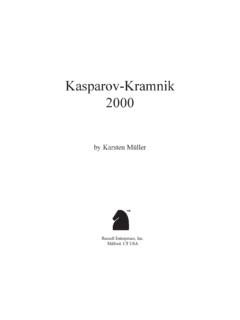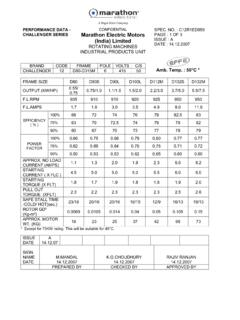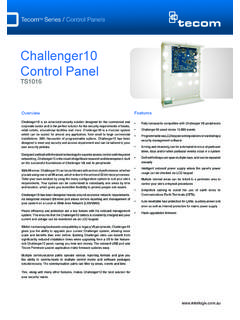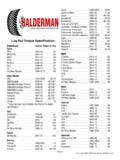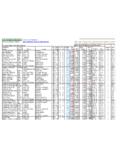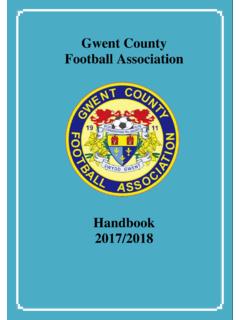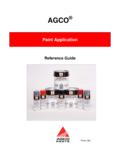Transcription of Gold deposits and fossicking areas in South Australia
1 July 2001. M9. gold deposits AND fossicking areas . IN South Australia . INTRODUCTION allows large quantities to be stored in a small space: 1 tonne (t) of gold occupies only m3. gold , silver and platinum are known as noble Because gold has a high electrical conductivity metals because of their superior resistance to and is resistant to disintegration, it is used in oxidation, corrosion and disintegration. gold is electronics applications such as computers, radar unrivalled for durability, versatility and its equipment, satellites and space technology. lustrous yellow sheen. The chemical symbol for Chemical inertness makes gold useful in dentistry gold (Au) comes from the Latin word aurum', and medicine.
2 Meaning shining dawn. Jewellery accounts for about 80% of gold PROPERTIES OF gold consumption per year. Minor uses include coins, electronics and dentistry (13%), and bullion (7%). gold is a soft, yellow metal with a specific gravity of , hardness of to and melting point of 1 063 C. It crystallises in the isometric gold PRODUCTION. (cubic) system, with cubes and octahedrons being Total world production to the end of 1999 was the most common habits. gold in its pure form is 139 530 t. Annual world production was 2 330 t malleable, an excellent conductor of both in 1999. electricity and heat, and is ductile.
3 It has been estimated that one ounce ( g) of gold can be Nearly 40% of all gold mined in the western beaten into a sheet with an area of 9 m2, or drawn world has been produced in South Africa. into a fine wire 80 km long. One-third of the gold produced is held as reserves in central banks, one-third is held in personal Native gold is rarely pure, frequently being reserves and the remaining third is used in alloyed with silver and sometimes with small jewellery, industry and other fabricated products. amounts of copper, iron, tellurium, bismuth and mercury. The gold content of a gold alloy is Australia produced 299 t in 2000, making it the defined by its carat' rating; pure gold (100%) is world's third largest producer after South Africa 24 carat.
4 gold purity is described by the term with 440 t and USA with 330 t. For comparison, fineness'; pure gold is 1 000 fine. Fineness of Australia produced 39 t of gold in 1984 and was vein gold ranges from 500 in electrum an alloy ranked seventh in the world. In recent times, of gold with high silver content to 800 or 850. Australian gold output peaked in 1997 at 314 t. Alluvial gold varies in fineness from 500 to 999. Overall the increase in output has resulted mainly gold is readily distinguished from other yellow from new discoveries in old mining areas and minerals such as pyrite, chalcopyrite, limonite increased throughput from established mines, and mica by its specific gravity and malleability.
5 With some contribution from retreatment of old tailings dumps using modern recovery techniques. USES OF gold However, discoveries of gold deposits in greenfields' areas (those without significant gold , because of its rarity, durability, colour and previously known mineralisation) have also been chemical inertness, has been used throughout an important factor. Many of the latter type of history as a medium of exchange, a store of discoveries have been in areas where near-surface wealth and for jewellery and decorative mineralisation is obscured by soil and sediment ornaments. cover; examples of this are the Challenger It is portable, and universally accepted in trade discovery in northwest South Australia and Portia between people and nations.
6 The density of gold in the northeast. The use of modern geochemical gold deposits and fossicking areas in South Australia and geophysical techniques in such areas is a feature of Kilograms OLYMPIC. 1250. exploration in Australia today. Discovery of goldfields DAM (approx. 3400 kg). Wallaroo-Moonta Mines in operation Western Australia is the largest producer with about 69% of (Recorded gold production from 1900 only). 1000. Australia 's total. South Australia has not been a major ECHUNGA. producer, with records showing a little over 26 t, representing BAROSSA. ULOOLOO. about of the Australian total before production began at 750 WAUKARINGA.
7 OLYMPIC DAM. the Olympic Dam copper-uranium- gold -silver mine (Fig. 1). WADNAMINGA MONGOLATA. TEETULPA. 500 TARCOOLA. HISTORY OF gold MINING IN South NILLINGHOO. MT GRAINGER. DELORAINE. Australia 250. WOODSIDE. KANMANTOO. The first recorded production of gold in South Australia was no record in 1846 from the Victoria Mine near Castambul, 18 km 0. northeast of Adelaide (Fig. 2). The discovery of rich 1850 1860 1870 1880 1890 1900 1910 1920 1930 1940 1950 1960 1970 1980 1990 2000. 98-1595. specimens caused great excitement but the mine failed to live up to expectations; less than 1 kg of bullion was produced and Fig.
8 1 South Australian gold production 1852 2000. interest soon waned. The history of subsequent discoveries is characterised by a Further discoveries followed at Para Wirra (1869), Birdwood series of short periods of high gold production as large and Ulooloo (1870), Waukaringa (1873) and Woodside numbers of men rushed to, and quickly exhausted, each new (1879). Sporadic prospecting was also centred on the Peake find. These gold rushes had a significant effect upon and Denison Inliers following the discovery of alluvial gold at population movements within the State, although not as Algebuckina on the Neales River in 1870 (Fig.)
9 3). marked as mineral discoveries elsewhere, such as the The discovery of rich lead-zinc-silver lodes in NSW at Victorian gold rushes of the early 1850s, which drew large Silverton and, subsequently, the massive high-grade Broken numbers of men from South Australia . Hill orebody, led to completion of the railway from In 1851, the South Australian Government offered a 1 000 Peterborough to Cockburn in 1887. This aided the efforts of reward for the discovery of a payable goldfield. The first prospectors in the Olary region and contributed to discoveries claim to this reward was by Messrs Chapman, Hardiman and of gold at Manna Hill (1885), Teetulpa (1886), Kings Bluff Hampton following the discovery of alluvial gold near (1887), Wadnaminga (1888) and Mount Grainger (1891).
10 Echunga early in 1852; other discoveries in the vicinity The discovery of gold -bearing alluvial deposits at Teetulpa by followed. Chapmans Gully (the site of the original find) and Messrs Brady and Smith in October 1886 saw 5 000 miners Donkey Gully saw the most concerted mining efforts, on the field within two months; the field was virtually particularly during the period 1852-58. The discovery nearby deserted by 1889 after having produced an estimated of the Jupiter Creek alluvial diggings by Messrs Plane and 3 100 kg. Saunders in 1868 led to another period of intensive activity.

